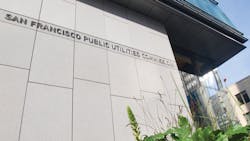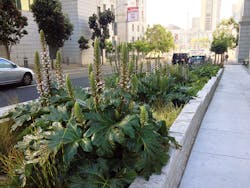San Francisco’s One Water Approach to Resiliency
As communities across the country feel the impacts of water stress, whether from drought, population growth, or myriad other factors, water conservation programs have become an integral part of water resource planning and sustainability efforts. Nowhere is this more apparent than in California. Paula Kehoe, director of water resources for the San Francisco Public Utilities Commission, spoke with us about SFPUC’s approach to water resiliency.
WATERWORLD: San Francisco’s approach to water resource management has become a model for water conservation. In fact, your per capita water usage is down to 42 gallons per day. What are some of the major components of your program?
PAULA KEHOE: San Francisco has been promoting conservation for more than 25 years and it’s truly a partnership with our community as they’ve responded to all of the work we’ve been doing to encourage consumers to use water more efficiently. That’s resulted in this wonderful per-capita rate of 42 gallons per person per day, which is about half the statewide average.
We have a very comprehensive program with a number of different tools and strategies to help our customers, whether they are residential or commercial. We have a team of staff that go out and do water audits at businesses and commercial entities, as well as homes, to point out ways to save water. We have a direct install program where we will actually go into a home or a business and install a water-efficient toilet or urinal. We have laundry-to-landscape measures where we work with residential customers that have washing machines and want to use their wash water to irrigate their yard. We have rain barrels and cisterns to give to our homeowners to capture rainwater and reuse [it]. And we also provide a number of rebates for our industrial water customers.
WW: One of the aspects of the program that is particularly fascinating is your wastewater reuse strategy, which is really unique. It combines both centralized and decentralized components, with potable and non-potable end uses. Can you elaborate?
PK: Certainly. San Francisco, as you said, has taken a unique approach to water recycling that has a lot to do with our geography and the land use in the city itself. On the west side of the city, we have large parks and golf courses, which really lends itself nicely to building centralized recycled water facilities to irrigate the golf courses and the parks. For example, we’re currently building a recycled water treatment plant to irrigate over 1,000 acres of Golden Gate Park. We’ve also partnered with other communities that have recycled water facilities to use recycled water to irrigate our golf courses.On the east side of the city, though, we have a lot of dense buildings. For example, we see a lot of rapid growth in terms of high-rise buildings. The opportunity to collect water on site with decentralized water treatment systems is a wonderful way — and a significant way — of reducing potable water consumption for things like toilet flushing, irrigation, and cooling. And those decentralized water treatment systems are integrated with our centralized infrastructure, so they create a greater resiliency for our traditional pipe networks here in San Francisco.
We’re also starting to see a lot of different kinds of applications here in the city. For example, a new sports arena is going to capture gray water and condensate and rainwater, and then reuse that water to flush the toilets in the arena as well as for irrigation around the arena itself. This provides a great opportunity to talk about water with folks who are coming to the arena. We can talk about how the facility is reusing water and further educate people about the value of water and how we’re reusing water here in San Francisco.
WW: All of these strategies are in line with a “one water” approach. Is that your objective?
PK: Yes. The San Francisco Public Utilities Commission has adopted a One Water SF approach and it’s an exciting opportunity where we can look at managing our water supplies from a more integrated water management approach. It enables us to use the right water for the right use. It also enables us to build upon our centralized pipe networks.
Our approach really embodies the concept of one water. Within our local water program we have a conservation program, a groundwater program, a recycled water program, we have on-site water reuse, and we also have an innovations program. In San Francisco, we’re taking an all-of-the-above approach; it’s not just one solution or strategy but a number of different strategies in order to make our system more resilient.
WW: And you practice what you preach at your main headquarters. Tell us about the system you have there.
PK: It’s great to have the opportunity to practice what you preach. In 2012 we moved into our new headquarters in downtown San Francisco. During the time of constructing and thinking about the building, we decided we needed to incorporate an on-site decentralized water treatment system. Certainly, if we are encouraging and wanting other buildings in San Francisco to incorporate decentralized systems, we should be doing that ourselves.
That’s led to a wonderful opportunity where we have an engineered wetland treatment system. It looks like a series of large planter boxes surrounding our building. People might think they are just plants but it’s actually a system that’s treating all of our black water, our wastewater, that would normally go to the sewer system. That water is also disinfected with ultraviolet light and chlorine, and then it’s sent back up for use in the toilets and urinals in the building. The system has enabled us to reduce our potable water consumption by 60 percent. So it’s a tremendous opportunity that we have here at the utility as well as a showcase for other buildings in San Francisco about using water efficiently here in the city.
WW: With regard to on-site water reuse, it’s now a mandatory requirement for new construction in San Francisco. What’s the response been to that decentralized approach, from builders as well as from the utility?
PK: We’re finding that the private sector is really embracing the opportunity to incorporate decentralized water treatment systems. Prior to the mandate, we actually had building developers coming to us asking us how they could install an on-site water treatment system in their new buildings because they wanted to get LEED platinum rating, they wanted to build green buildings, sustainable buildings. So we saw it as an opportunity to partner with the private sector and streamline the permitting process for new developers.
We’re also seeing a lot of different kinds of applications. We’re seeing new developments incorporating and thinking about wetland treatment systems similar to the one in our building. Other buildings and other developers are moving towards membrane bioreactors, more packaged treatment systems, in the basements of their buildings.
They are also on different scales. It could be an individual building like our headquarters or it could be multiple buildings in a redevelopment project pursuing decentralized water treatment systems. Again, it really provides the opportunity to potentially reduce the water consumption by anywhere from 25 to 50 percent. It also helps potentially lower the water and sewer bills within these new developments. And we have also found that these systems haven’t caused any impacts to our sewer system. So again, it’s really creating a greater resiliency here in San Francisco.
WW: This is not the only example of SFPUC’s innovative approach to water; there are several others. Can you describe a few of them?
PK: The SFPUC has established an innovations program. We have a number of different types of projects in that program. For example, we have Pure Water SF. We’re actually taking the wastewater in our building that goes through our engineered wetland treatment system, and we’ve added additional technology to treat water to a standard that’s comparable to drinking water. That’s one of our innovations in terms of looking at the role of online monitoring and real-time monitoring in order to produce water from wastewater to meet drinking water standards.
We’ve also been working with our local breweries here in San Francisco. It takes anywhere from 5 to 7 gallons of water to produce one gallon of beer. Certainly, it’s a significant opportunity to reduce the use of water so we’ve developed our own chemical and pathogen control strategy as well as a grant program to encourage breweries to treat water on site for reuse within the brewery as well as to potentially produce beer.
We are also looking at atmospheric water generation technologies. There are a whole slew of new technologies on the market today anywhere from fog-catcher type technologies to more simple, passive solar panels that have the ability to produce water that we can use for irrigation in our community gardens or … to produce water that can be used in emergencies and to increase our resiliency here in San Francisco.
We’re also looking at heat exchangers. We want to encourage these new developments [using decentralized water treatment systems] to incorporate heat exchangers … to create thermal energy and to reduce the overall energy footprint within buildings.
And finally, we’re looking at new technologies for detecting losses within our distribution system. For example, we’ve been testing acoustic listening devices that are on top of our fire hydrants to determine whether we have leaks in our underground pipe network. As you can imagine, it’s extremely expensive to dig up the streets if you think you have a leak. But these acoustic listening devices help us determine and pinpoint where a leak is actually occurring.
So those are just some of the innovations we’re thinking about and we are open to thinking about additional innovations here in San Francisco. WW
Editor’s Note: To learn more about SFPUC’s initiatives, visit sfwater.org.

